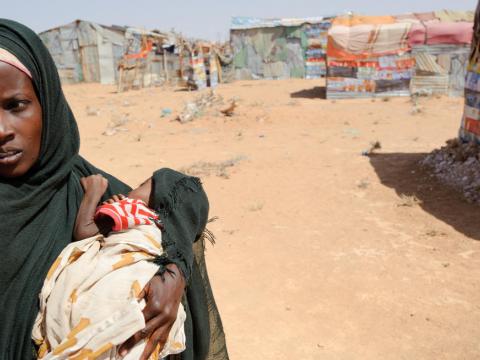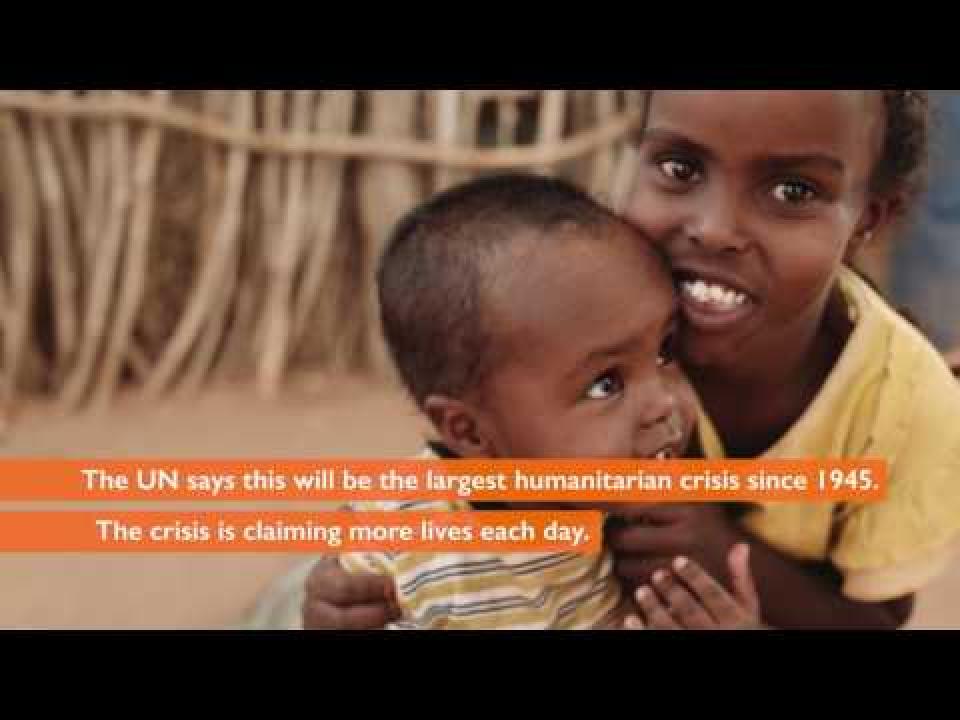
We told ourselves – We'd never let famine happen again
On the 10th Anniversary of the Somalia Famine, Sheri Arnott asks: 'How did we get here again?'
In 2017, my colleagues in Somalia spent much of their time with farmers experiencing that year's drought, "This is the worst drought I have ever experienced," 85-year-old Mohumed told us.
This elder had experienced droughts his whole life – including the 2011 famine that was caused by a deadly mix of conflict which reduced access to starving populations, a drought which deeply affected the entire Horn of Africa region and restrictive donor policy designed to combat terrorism which reduced funding and blocked remittances from Somali family members working outside the country. This resulted in the largest famine in the world since the establishment of a global interagency system for assessing and agreeing on how to measure the level and intensity of food security crises called the Integrated Food Security Phase Classification (IPC) in 2006. 1 In 2011, Mohumed and others in his village had watched many friends and family perish. He had stood by helplessly while his livestock and household assets his family needed to recover from the crisis either died or had to be sold off to buy food.
All told, the 2011 Somalia famine left 260,000 people dead, half of whom were children under five years of age, by the time it was ''undeclared” in February 2012. It is estimated that half of the people who died did so even before the international community issued a formal famine declaration on 20 July 2011. Early warning systems first warned of severe drought in Somalia (and across East Africa) in August 2010, and an urgent alert that famine would likely occur was issued in March 2011. Despite being warned multiple times well in advance, the international community was slow to react, leading to a massive, yet preventable, loss of life.
As the complete picture of the tragedy emerged, the international community bowed their heads and pledged never to let this happen again.
Ten years on, I can remember that promise as I reflect on the almost unimaginable scale of what we're currently facing worldwide.
I've seen the best of what we can do when we as an international community come together. Since the 1990s we'd seen incredible progress in reducing hunger and extreme poverty across the globe. The humanitarian community has dramatically improved its ability to spot and respond to acute hunger crises. Unfortunately, over the past five years, we've seen this hard-won progress take a sharp turn for the worse. The numbers of people experiencing hunger has dramatically increased in many countries, with children living in the most fragile and dangerous places in the world hit the hardest. This decline is driven by a deadly mix of conflict, climate change and the socioeconomic impacts of the COVID-19 pandemic.
More than a year after WFP's Executive Director warned of "a famine of Biblical proportions" if the international community didn't act quickly to prevent a large-scale food crises across multiple countries, I’m sad to say that Mr. Beasley’s warning is very close to becoming a reality. There are already 41 million people suffering from "Emergency" (IPC 4[1]) levels of food insecurity and, even more alarmingly, 522,000[2] people experiencing Catastrophe/Famine (IPC 5) levels of food insecurity - a more than 300% increase in three months. Of the top ten countries facing the highest burden of Emergency and Catastrophe/Famine levels of food insecurity, all have longstanding humanitarian response plans and seven of these are categorised as 'extremely fragile' by the OECD.[3]
Don't let the large numbers and technical jargon obscure the reality of what we're looking at. Every number represents a real woman who hasn't eaten today, a child who can't go to school because his parents can't afford the fees or don't want to send their child to school hungry - a choice no parent should have to make. It means that the equivalent of more than every single person in Canada -- which opened its doors to my great grandparents when they fled the Ukraine famine of the 1930s -- only eating once a day or every few days.
The parallels between Somalia ten years ago and the current severe food insecurity situation in multiple countries are clear. In April 2020, WFP warned that the Covid-19 pandemic would dramatically increase food insecurity, particularly in countries with already high humanitarian case loads. In March 2021, WFP and the FAO issued an urgent Call to Action to Avert famine. Since then, the G7 committed a welcomed US$7 billion under their Compact on Famine Prevention and Humanitarian Crises, but these commitments aren’t translating into lifesaving resources for hungry people quickly enough.
Responding to crises once they hit is an expensive proposition, in terms of the financial outlay required. But, more importantly is the incalculable cost of human suffering as a mother or father watches helplessly as their young daughter or son wastes away due to lack of food and access to life-saving medicines.
We have a moral obligation to respond to immediate food crises and make smart investments over the longer term to end food crises once and for all. This requires greater support to work across the humanitarian-development-peacebuilding nexus to reduce humanitarian need and promote sustainable livelihoods and the resilience of the most vulnerable people. We know that collective will and immediate assistance works to beat back famine in the short-term; back in 2017 when we last faced the spectre of large-scale famine in multiple countries the international community came together to ‘beat back’ famine and saved millions of lives. Unfortunately, we didn't keep up the momentum to take it the next level and make the necessary long-term investments to make sure the threat of famine-or famine itself became a thing of the past.
On 20 July 2021 - the 10th anniversary of the famine declaration in Somalia - let's remember the actual consequences, particularly on children, of the international community's failure to act urgently despite many early warnings. Let's recall what will happen if commitments by donors aren't quickly translated into getting life-saving resources into the hands of those that need them now. Let's reflect on the enormous human and financial costs of not investing over the long-term to address the underlying drivers of food crises and build the resilience of children, families and communities to repeated shocks and stresses. And most importantly, let us urgently come together to fight famine again and resolve to make it a thing of the past, once and for all.
Sheri Arnott is a food security expert and Director of Policy, Disaster Management in World Vision's global humanitarian team.
Photo Credit: Muuse Rootile IDP camp Somalia ©2011 World Vision/photo by Jon Warren
[1] The Integrated Food Security Phase Classification (IPC) system is 1) a standardised scale of food insecurity; and 2) a process for building interagency technical consensus on the state of food insecurity in a specific country at a given moment and aims to inform evidence-based decision making. The 5 ‘phases’ of the IPC scale are: Phase 1 (None/Minimal), Phase 2 (Stressed), Phase 3 (Crisis), Phase 4 (Emergency) and Phase 5 (Catastrophe/Famine).
[2] # of people in IPC 5 as of June 2020: Ethiopia (353,000); South Sudan (108,000); Yemen (47,000); Madagascar (14,000)
[3] OECD. 2020. States of Fragility 2020. Paris: OECD Publishing. 17 September. https://doi.org/10.1787/ba7c22e7-en.
